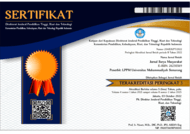Persoalan Kerawanan Pangan pada Masyarakat Miskin di Wilayah Perbatasan Entikong (Indonesia-Malaysia) Kalimantan Barat
(1) Fisip Universitas Padjadjaran
(2) Universitas Padjadjaran
(*) Corresponding Author
Abstract
handling of food issues at the borders of the country. Border society is still food dependence on Malaysia. The idea of making Indonesian society self-sufficiency in food has long been a crucial sector of individual attention to the Government. Many empowerment programs are found in the community that is the meeting point for overcoming food insecurity, so it is a new way for
the border community out of the inferior zone. The method used is a descriptive exploratory where the source of the data comes from the primary data referring directly to the situation of the border society of Entikong, while the secondary data of the desk review results related to the potential and state of the food community In the Entikong border area. The findings in this paper are that Entikong has economic potential, strategic location, and formal access support that has been qualified to advance. However, this situation is uneven; there are still areas of isolated villages and limited access. Then, the construction of international Terminal Goods (TBI) on the border became a breath of fresh air for the Entikong to multiply and make Entikong as the center of activity and economic development, including the food Center for the region Indonesia and as part of Malaysia.
Keywords
Full Text:
PDFReferences
Anonim. (2019). Global Hunger Index: the Challenge of Hunger and Climate Change. Retrieved from: https://www.globalhungerindex.org/pdf/en/2019.pdf
Anonim. (2019). World Poverty Clock. Federal Ministry for Economic Cooperation and Development. Retrieved from: https://worldpoverty.io/index.html
Badan Ketahanan Pangan Kementerian Pertanian. (2018). Indeks Ketahanan Pangan Indonesia 2018. Jakarta: Kementerian Pertanian Republik Indonesia.
Badan Ketahanan Pangan Kementerian Pertanian. (2019). Laporan Kinerja Pusat Ketersediaan dan Kerawanan Pangan Tahun 2018. Jakarta: Kementerian Pertanian Republik Indonesia.
Badan Pusat Statistik. (2016). Kajian Indikator Lintas Sektor Potret Awal Tujuan Pembangunan Berkelanjutan (Sustainable Development Goals) di Indonesia. Jakarta: Badan Pusat Statistik Nasional.
Badan Pusat Statistik. (2018). Kalimantan Barat dalam Angka. Pontianak: BPS Kalimantan Barat.
Creswell, J. W. (2010). Research Design: Pendekatan Kualitatif, Kuantitatif, dan Mixed. Yogyakarta: Pustaka Pelajar.
Hermanto (2015). Ketahanan Pangan Indonesia Di Kawasan Asean. Forum Penelitian Agro Ekonomi, 33(1): 19-31.
Khudori. (2008). Ironi Negeri Beras. Insisist Press: Jakarta.
Lantarsih, R., dkk. (2011). Sistem Ketahanan Pangan Nasional: Kontribusi Ketersediaan Dan Konsumsi Energi Serta Optimalisasi Distribusi Beras. Analisis Kebijakan Pertanian, 9(1): 33-51.
Lassa, J. (2005). Politik Ketahanan Pangan Indonesia 1952-2005. Retrieved from: https://www.researchgate.net/publication/326146082_Politik_Ketahanan_Pangan_Indonesia_1950-2005/link/5b3b06eb0f7e9b0df5e83d2c/download
Maxwell. S. (1994). Food Security: a post-modern Perspective. Working paper 9 Institute of Development Studies University of Sussex, England.
Niko, N. (2019). Kemiskinan Perempuan Dayak Benawan di Kalimantan Barat sebagai Bentuk Kolonialisme Baru. Jurnal Pemikiran Sosiologi, 6(1): 58-76.
Niko, N., & Samkamaria. (2019). Terminal Barang Internasional (TBI) dalam Konteks Pembangunan Ekonomi Masyarakat di Perbatasan Entikong, Indonesia-Malaysia. Indonesian Journal of Religion and Society, 1(2):104-114.
Prabowo, R. (2010). Kebijakan Pemerintah Dalam Mewujudkan Ketahanan Pangan di Indonesia. MEDIAGRO: Jurnal Ilmu-Ilmu Pertanian, 6(2): 62 – 73.
Santoso, I., Jarot, S., dan Slamet, R. (2006). Model Pengembangan Hutan Cadangan Pangan Melalui Pendidikan Non Formal untuk Penanganan Kerawanan Pangan Rumah Tangga Petani Tepian Hutan. Jakarta: Kerja sama Lembaga Penelitian Universitas Jenderal Soedirman dengan Kementrian Negara Riset dan Teknologi Serta LIPI.
Santoso, Imam. (2014). Pengembangan Masyarakat Berbasis Sumber Daya Lokal. Yogyakarta: Pustaka Pelajar.
Suharyanto, H. (2011). Ketahanan Pangan. Jurnal Sosial Humaniora, 4(2): 186-194.
Sulaiman, A. A., dkk. (2018). Sukses Swasembada Indonesia Menjadi Lumbung Pangan Dunia 2045. IAARD Press: Jakarta.
Winarno, B. (2010). Melawan Gurita Neoliberalisme. Jakarta: penerbit erlangga.
Winarno, B. (2014). Dinamika Isu-Isu Global Kontemporer. Yogyakarta: CAPS.
Article Metrics
Abstract view : 2172 timesPDF - 861 times
DOI: https://doi.org/10.26714/jsm.2.2.2020.94-104
Refbacks
- There are currently no refbacks.
Copyright (c) 2020 Jurnal Surya Masyarakat

Jurnal Surya Masyarakat (JSM) is licensed under Creative Commons Attribution-NonCommercial-NoDerivatives 4.0
------------------------------------------------------------------------------------------------------------------------
Jurnal Surya Masyarakat (JSM)
p-ISSN: 2623-0364; e-ISSN: 2623-0569
Published by: Lembaga Penelitian dan Pengabdian Masyarakat (LPPM) Universitas Muhammadiyah Semarang



.jpg)







.jpg)